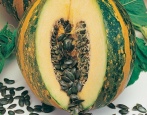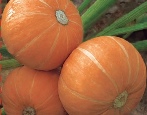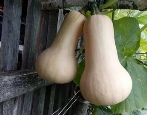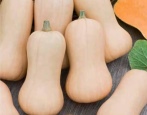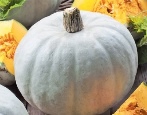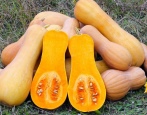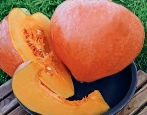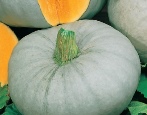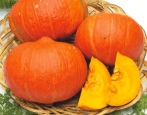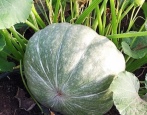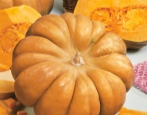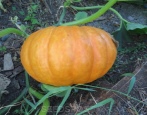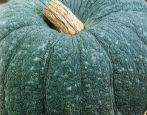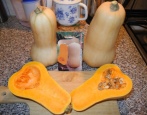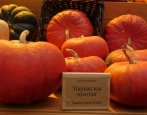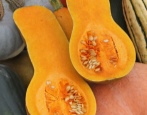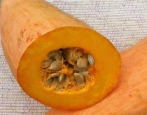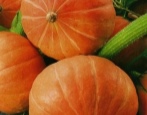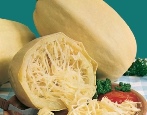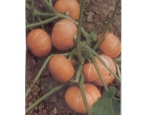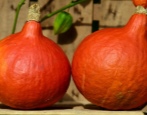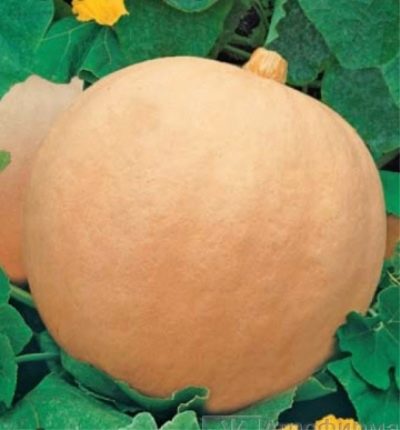
- Year of approval: 1947
- Growth type: medium power
- Lash length, m: up to 7
- Leaf shape: reniform
- Petiole: long
- Petiole length, cm : up to 40
- The form: spherical and short-oval
- Weight, kg: 10-20
- Coloration: pink, yellow, orange and gray
- Bark: thin, flexible
Pumpkin 100-pound is a classic variety highly appreciated by professional agronomists and summer residents. It is successfully grown for processing on juices and purees, producing record-sized fruits without much effort. The pumpkin pulp of this variety is rich in pectins and mineral salts, vitamins, suitable for baby and diet food.
Breeding history
One hundred pound is a pumpkin entered in the State Register back in 1947. The originator today is the Association for Seed Production of Vegetable Crops "Sortsemovosch". Information about the breeders who participated in the breeding has not been preserved.
Description of the variety
This pumpkin belongs to the category of large-fruited fodder melons. Differs in good keeping quality, suitable for winter storage. Transfers transportation normally. Pumpkin bushes of this variety tend to grow intensively in width, while their root system does not differ in depth, but is able to actively absorb nutrients. Its central part goes into the ground by 0.5-0.7 m.
Cross-pollinated plants. It is not recommended to plant the Hundred Pound at the same time next to other pumpkin varieties, in order to avoid hybridization. For pollination, the plant needs bumblebees on the site. Flowers are dioecious, males appear earlier than females, until the central shoot is fully developed.
Characteristics of the appearance of plants and fruits
Plants are long-leaved, with medium vigor. Lateral shoots are long, the main one is 20-30% shorter. Leaves on petioles about 40 cm in size, kidney-shaped, wide, dark green in color, with lighter veins. The central stem is well developed, has a cover in the form of a spiny cannon.
The fruits of this pumpkin variety are spherical and short-oval, weighing about 10-20 kg. They are weakly segmented, with a thin flexible bark of pink, gray, orange and yellow colors, a smooth outer surface and a large seed nest inside. The pulp is 40-50 mm thick and is cream-colored. May be yellow. The brightness of the outer and inner color depends on the stage of maturity, growing conditions.
Purpose and taste
The variety is intended for any kind of processing. It can be used in cooking, as well as fresh, in salads. It is grown as a fodder crop in agriculture. The pulp is sweet or slightly sweet, with a satisfactory taste, and a friable consistency.
Ripening terms
The variety is medium late, the harvest is harvested in August-September, after 112-138 days from the moment of emergence.
Yield
One hundred pound pumpkin yields an average yield of 32.4-63.0 t / ha. Its performance is assessed as high.
Growing regions
The variety is limited in the choice of climatic zones for cultivation. Zoned for the Middle Volga, North Caucasian and Volga-Vyatka regions.
Growing and care
For seedlings, Hundred Pound Pumpkin seeds are sown in April. In May-June, the grown plants are transferred to a permanent place. The optimal sowing scheme for them is 60x60 cm. The variety is sensitive to watering, it needs strict adherence to its norms and recommended frequency. At the same time, the constant preservation of dampness at the roots is contraindicated in the pumpkin.When watering, it is also extremely important to ensure that water does not fall on the leaf plates, otherwise burn marks may remain on it when it comes into contact with the sun's rays.
Seedling the variety is grown only in temperate and cold climates. Seeds are sown directly into the soil, only after it warms up to +15 degrees and above. The material is discarded, separating the empty shells, first placed in the wells, 3 pieces each. After germination, thin out, leaving the strongest.
The feeding regime is very important for the Hundred Pound Pumpkin. For the first time, it is fertilized with nitrophos in 3-4 weeks from the moment of emergence. Then, after 14 days, a mullein solution is introduced under the bushes. After another 2 weeks, fertilize with a potassium-phosphorus complex. After the formation of inflorescences, the soil is enriched with an aqueous solution of wood ash.
Requirements for soil and climatic conditions
Plants need long daylight hours. Can be cultivated on any type of soil, but thrive best in loose, well-manicured or organic-rich areas. The variety does not tolerate cold and drought. For young plants, recurrent frosts can be detrimental.
Disease and pest resistance
The variety is well protected from the most common diseases of melons. It is moderately affected by bacteriosis, powdery mildew. It is relatively resistant to fruit rot. For prophylaxis, it is recommended to use copper-containing fungicides. During the period of flowering and the appearance of sprouts for young pumpkin bushes, aphids and spider mites are dangerous.
Review overview
Pumpkin Hundred Pound is considered one of the most beloved varieties among farmers who grow products for processing. In terms of mass, its fruits can be ranked among the champions. Summer residents rarely decide on such large varieties for planting, having difficulties with processing the crop. At the same time, they note unusually large seed sizes that do not affect their germination.
It is also mentioned in the reviews that the pumpkin mass build-up directly depends on the fertility of the soil and climatic conditions. In the warm, on chernozem soil, the indicators will be higher than in the temperate zone on loam. As for the palatability, they are rated as moderately sweet, but pleasant. According to reviews, the pulp is mainly used for making pies, pancakes, cereals.
To the obvious disadvantages of the variety, amateur vegetable growers include the attractiveness of seedlings and ripening fruits for pests. Summer residents who want to save crops, slugs and snails are especially annoying. And also not everyone likes the large number of seeds inside, but they allow you to avoid additional expenses when harvesting planting material for subsequent seasons.
